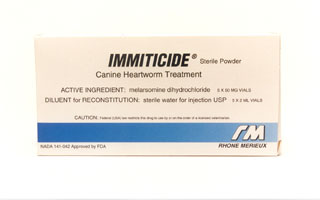
| For a dog that has been positively diagnosed with a heartworm infection, Immiticide can be given as part of the treatment. |
Introduction:
Heartworm disease is found all over the world. In the U.S.A., the disease has been found most commonly in the East, South, and Midwest areas. With time, the disease is spreading to every area of the country. Heartworm disease is one of the most serious infectious diseases encountered in canine medicine.Causative Agent: Heartworm disease is caused by the parasite Dirofilaria immitis. The parasite begins its life cycle as microscopic organisms called microfilariae. Microfilariae enter a dogís circulatory system through the bite of an infected mosquito. Once the infective larvae enter the tissues and blood stream of the dog, they grow and mature into adult stage worms. After this phase, they begin to migrate to the heart and lungs. Adult worms can measure as much as 27 cm in length.
Clinical Signs: The most common signs of heartworm disease include coughing, weight loss, fever, and a lack of energy. Additionally, signs of more progressed disease include difficulty breathing, fluid in the abdomen, and swelling of the extremities. If the worm has progressed to the heart, severe weakness, collapse, and sudden death can occur. In some cases, heartworm disease may cause damage to the kidneys; consequently, an animal will have increased thirst and need to urinate.
Disease Transmission: Heartworm disease is indirectly spread from animal to animal through the bite of a mosquito. Any other method of sharing blood or blood products between dogs, such as blood transfusions, may also cause disease transmission. Heartworm disease is not transmitted by direct animal to animal contact.
Diagnosis: If any animal is suspected of having heartworm disease, a simple and accurate test may be performed in the clinic. See page D308 for information on this test. In rare situations, tests on some animals with heartworms produce a negative test result. If this occurs, additional testing may be necessary. Because treatment is most successful if the diagnosis is made early, routine screening of healthy pets for heartworm disease is highly recommended.
Treatment: Older methods of treating this problem involved using a product that had some very severe side effects. Because of this, the animal was hospitalized and carefully monitored. Newer and safer medications have since been introduced that are not as dangerous. However, it is important to understand that treating any dog with heartworm disease does carry risks, and some animals have died during treatment.
Treatment consists of initially killing the adult worms in the heart. Injections of specific drugs with this capacity are first administered. As the worms die, their bodies must be absorbed by the animalís body. Strict rest is encouraged for the next 4-6 weeks, as the dead worm bodies may fragment with any strenuous activity. These fragments can act as deadly blood clots, possibly causing heart attacks, strokes, and a variety of other problems. After this phase of treatment, another medication must be administered to destroy the microfilariae. After another waiting period, the dog is retested for heartworm. If the dog tests negative, it is placed on a preventative program.

|
|
Prevention: Once a dog is determined to be heartworm free, any of the preventative products may be recommended. These products are very safe for most animals. See page C348 for more information on heartworm prevention.
Precautions: All animals should be blood tested before any preventative measures are taken. Placing a dog already infected with heartworm disease on any type of prevention may result in the death of that animal! Because of potential problems, it is recommended that a veterinarian be consulted before initiating preventative therapy in Collies, Shetland Sheepdogs, and sight hounds.